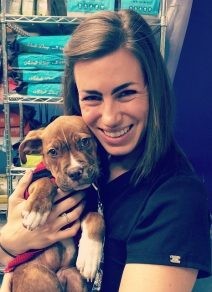Care for a Ruptured Disc
- Posted on
- By Dr. Christina Cole
- Posted in anatomy of the spine, chronic disc problem, disc bulge, disc rupture, ruptured disc
- 0

With disc disease becoming all too prevalent among our animals, one might begin to wonder what exactly could be the cause? Why does a disc begin to bulge, herniate, or rupture completely? More often than not, we are told that a ruptured disc is the cause of our animal's issues, but less often we are told why that disc ruptured in the first place. I figured now would be a great time to explain how that disc becomes liable to injury.
With disc disease becoming all too prevalent among our animals, one might begin to wonder what exactly could be the cause? Why does a disc begin to bulge, herniate, or rupture completely? More often than not, we are told that a ruptured disc is the cause of our animal's issues, but less often we are told why that disc ruptured in the first place. I figured now would be a great time to explain how that disc becomes liable to injury.
The Anatomy of a Ruptured Disc
To start, let’s review the basic anatomy. In the spine, we have a string of bony vertebrae that are cushioned in between by cartilaginous discs. The spine acts as a suit of armor protecting the spinal cord held within. The spinal cord is attached via the meninges to the inner portion of the vertebrae loosely, giving it some wiggle room. Remember, the spinal cord should not come in contact with the disc. When abnormal pressure is placed on the vertebrae, they will in turn increase their load on the discs. The discs act as pillows and shock absorbers, and will naturally return to their normal shape after the load is removed. If the load is not removed, or there is something restricting the discs from returning to normal placement, a bulge may begin to form. As more pressure is placed on the disc, more of the disc will bulge into the spinal canal. At a point it may begin to put pressure on the spinal cord and nerve roots.
When the disc has been bulging for an extended period of time, its elasticity diminishes and the outermost layers of the disc that hold the fluid inside will weaken. The weaker these become the more likely it is that this disc will eventually rupture. When a disc does rupture, its contents will spill into the spinal canal and cause this area to become horribly inflamed. Inflammation, while normally beneficial to the body, will start to aggravate the cord and nerve roots. When the inflammation doesn’t go away in a timely manner, the ruptured disc will begin to cause more permanent damage to the areas it touches.
Common Symptoms
For instance, when a disc ruptures one of the first signs one may see is a severe hunching in the area where it has occurred. The reason the spine will hunch is an attempt to relieve the pressure on the cord and its contents. Pain may also be a more common symptom. An altered gait or ataxia might also be noted, with an unawareness of where a limb is in space. Depending on where a bulge or rupture occurs, pain may be followed by dysfunction in the limbs and/or organs controlled by the nerves at that level. This would include bowel and bladder function if the disc rupture occurs in the lower lumbar spine. The absolute last process affected is the deep pain response. When an animal loses the ability to feel pain, the prognosis is not good. A disc rupture must be very severe for this to be affected, and if this is the case can take an incredibly long time to heal, though research has shown it is possible for a ruptured disc to be reabsorbed.
What Causes a Ruptured Disc?
A ruptured disc can be caused by a serious trauma, though we do see the more chronic disc problem in our practice. A structural shift can greatly alter the ability of the spine to return to a state of normal, thus disallowing the disc to return to normal positioning in the first place. When the structural shift is addressed, the normal motion is restored to the spine and the disc should have no problem recovering when a load is introduced and then removed.
Moral of the story: chiropractic adjustments aim to help restore normalcy in the body, thus relieving abnormal stress on the discs and the vertebrae. When the body is no longer impaired, the likelihood of a disc problem being present is greatly diminished. In the end, it will behoove your pet to be adjusted! Call The Pet Beastro at 248-548-3448 to schedule a chiropractic adjustment today!


Comments
Be the first to comment...